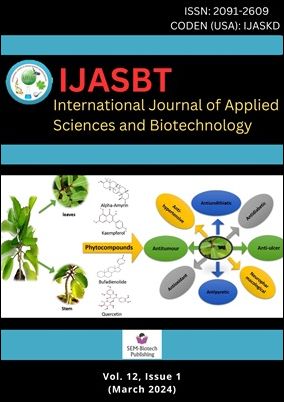Community Health Profile of Selected Area of Birgunj Metropolitan City, Parsa
DOI:
https://doi.org/10.3126/ijasbt.v12i1.64326Keywords:
Community Assessment, Community Health, Community ProfileAbstract
Background: Community assessment is the basic foundation for promoting and improving the health of community populations. The objective of this survey is to appraise the health profile of the community and assist in promoting community health.
Methodology: A descriptive cross-sectional survey was carried out from August 14, 2019, to September 21, 2019. The population of the study was residents of ward number 1, Chhapkaiya of Birgunj Metropolitan City, a Slum area of the ward selected purposively, where there were 200 houses and a total population was 1364. Data were collected using the interview technique. Descriptive statistics were used to analyse data.
Results: The majority (79.0%) of respondents threw waste in an open field. Only 19.0% of respondents had used latrines. Most women (80.25%) became mothers at the age of fewer than 20 years. More than half (57.31%) of pregnant women had done an ANC visit up to the fourth time, among them, 90.0% of respondents had delivered in a government hospital 86.0% of the mothers had colostrum feeding practiced as well and 90.12% had done exclusive breastfeeding up to 6 months. Female sterilisation (38%) were more common in the society. Above sixty percent (62.86%) of families, had done diarrheal management in the home of under 5 children.
Conclusion: The health profile of the Chhapkaiya community is satisfactory. All populations used safe water but open field defecation is prevalent and most of the population threw waste in the open field. The majority of the women became mothers below 20 years of age and home delivery is still practiced in this community.
Int. J. Appl. Sci. Biotechnol. Vol 12(1): 39-45.
Downloads
Downloads
Published
How to Cite
Issue
Section
License
Copyright (c) 2024 International Journal of Applied Sciences and Biotechnology

This work is licensed under a Creative Commons Attribution-NonCommercial 4.0 International License.




